Angel’s Trumpet Plant
- March 13, 2024
- 0 comment

The Angel’s Trumpet Plant, scientifically named Brugmansia, is a type of flowering plant that originally comes from South America. These plants are well-known for their big, trumpet-shaped flowers that are very eye-catching and beautiful.
People love to grow them because they add a lot of beauty and charm to gardens or homes with their striking appearance. They are sure to impress anyone who sees them with their ornamental value.

| Characteristics | Description |
| Scientific Name | Brugmansia |
| Common Names | Angel’s Trumpet, Datura, Trumpet Flower. |
| Family | Solanaceae |
| Native Region | South America |
| Plant Type | Perennial shrub or small tree |
| Size | Can grow up to 6-30 feet in height |
| Leaves | Large, broad leaves that can be 6-8 inches long, often with a coarse, green texture. |
| Flowers | Enormous, trumpet-shaped flowers that can reach up to 20 inches in length |
| Propagation | Primarily through cuttings, as seeds can be variable and less reliable. |
| Drought Tolerance | While they prefer consistent moisture, established plants exhibit moderate drought tolerance. |
| Cultural Uses | In many cultures, Angel’s Trumpet plants hold symbolic and spiritual significance. They are often used in religious ceremonies and traditional medicine. |
| Ecological Role | In their native habitat, Angel’s Trumpet plants play a role in the ecosystem by providing nectar for pollinators and serving as food for certain herbivores. |
| Notable Species | Some notable species of the Angel’s Trumpet plant include Brugmansia arborea, Brugmansia suaveolens, and Brugmansia versicolor. |
| Hardiness Zones | Generally zones 9 to 12; vary by species. |
| Growth Rate | Fast-growing when provided with ample water and fertilizer. |
| Lifespan | Perennial, can live several years with proper care. |
Botanical Beauty of “Angel’s Trumpet Plant”
The Angel’s Trumpet plant, also known as Brugmansia, is a beautiful flowering plant that is widely admired for its captivating appearance. Its large, hanging flowers and shiny leaves make it a standout in any garden or landscape, earning it a reputation as a popular choice for ornamental purposes. The plant’s botanical beauty is so enchanting that many people enjoy growing it to enhance the visual appeal of their surroundings.
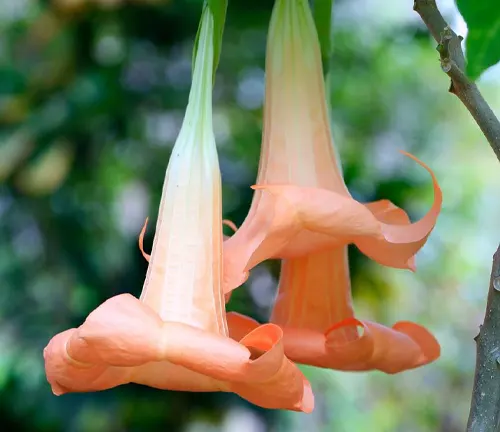
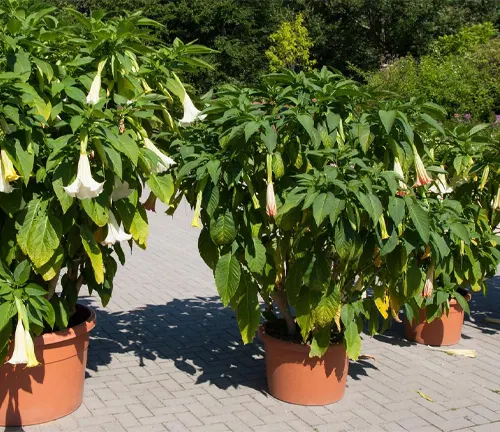
Woodland Elegance
In garden settings, Angel’s Trumpet plants bring a touch of woodland elegance with their graceful, hanging flowers and lush greenery. These plants create a charming and sophisticated atmosphere, enhancing the beauty of any outdoor space. Their delicate blooms and vibrant foliage contribute to a serene and enchanting ambiance, making them a popular choice for those seeking to add a touch of natural beauty to their gardens.
Ecological Importance
In its natural environment, the Angel’s Trumpet plant plays a vital role in supporting biodiversity by attracting pollinators like bees and butterflies, and providing food for certain animals. This plant helps maintain a healthy ecosystem by serving as a crucial link in the food chain, ensuring the survival of various species. Its presence not only adds beauty to the surroundings but also contributes to the overall balance and sustainability of the ecosystem it inhabits.
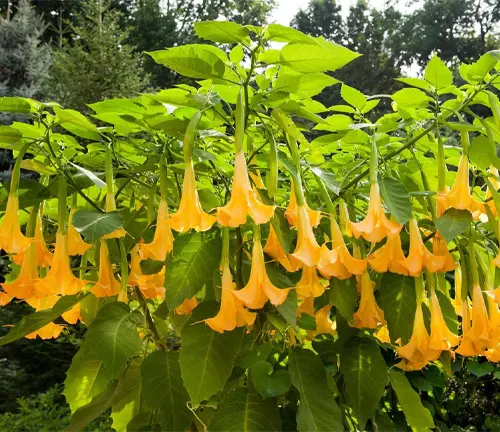

Cultivation and Conservation
Efforts are underway to grow and protect different species of the Angel’s Trumpet plant because of their beauty and ecological significance. By cultivating these plants, we can preserve their ornamental value and ensure they continue to thrive in their natural habitats. Conservation initiatives aim to safeguard these plants and the ecosystems they support, helping to maintain biodiversity and protect the environment for future generations to enjoy.
Fragrance
The Angel’s Trumpet plant is beloved for its flowers that release a sweet and captivating fragrance, which becomes particularly potent in the evening, creating a delightful experience for garden lovers. This enchanting scent not only pleases the senses of humans but also attracts nighttime pollinators like moths.
The alluring fragrance of the Angel’s Trumpet adds an extra layer of charm to gardens, enticing those who appreciate both the visual beauty and the aromatic allure of flowers in their outdoor spaces.
Soil Stabilization
Angel’s Trumpet plants are appreciated not only for their beauty but also for their practical benefits, such as soil stabilization. These plants have extensive root systems that help to hold the soil together, preventing erosion in certain landscapes.
This makes them a valuable addition to gardens or landscapes that are prone to soil erosion, as they help to maintain the stability of the ground and prevent damage caused by heavy rains or strong winds. By incorporating Angel’s Trumpet plants into their outdoor spaces, gardeners can not only enjoy their ornamental value but also reap the benefits of their root systems in maintaining soil stability and preventing erosion.
Common Uses
Angel’s Trumpet plants are not only admired for their beauty but also for their potential medicinal benefits. Traditionally, these plants have been used in herbal medicine for their therapeutic properties. Some of the common uses of Angel’s Trumpet plants in herbal medicine include:
- Pain relief: The plant has been used to alleviate pain, particularly in the treatment of headaches and muscle aches.
- Anxiety and stress: The Angel’s Trumpet plant has been used to help calm the mind and alleviate feelings of anxiety and stress.
- Sleep disorders: Some people use the plant to help treat sleep disorders, such as insomnia, by promoting relaxation and sleep.
- Digestive issues: The plant has been used to help alleviate digestive issues, such as nausea and indigestion.
It is essential to note that the use of Angel’s Trumpet plants for medicinal purposes should be done under the guidance of a healthcare professional, as they contain compounds that can be toxic if not used properly.
Benefits
The Angel’s Trumpet plant is not just a pretty flower; it offers a range of benefits that go beyond its captivating beauty. In addition to enhancing the aesthetic appeal of gardens and natural landscapes, this plant plays a crucial role in the ecosystem. Its large, trumpet-shaped flowers attract pollinators like bees and butterflies, supporting biodiversity.
Furthermore, the plant serves as a food source for certain animals, contributing to the overall balance of the ecosystem.By cultivating Angel’s Trumpet plants in gardens and natural landscapes, individuals can enjoy their ornamental value while also supporting local wildlife and promoting a healthy ecosystem.
These plants provide a harmonious blend of beauty and ecological significance, making them a valuable addition to any outdoor space. Whether for their stunning appearance or their role in sustaining biodiversity, Angel’s Trumpet plants offer numerous benefits that make them a popular choice among gardeners and nature enthusiasts alike.
Different Species
Brugmansia Aurea
Known as the Golden Angel’s Trumpet, this species boasts bright yellow to gold flowers. It’s native to the Andes mountains in South America and prefers cooler, high-altitude environments.
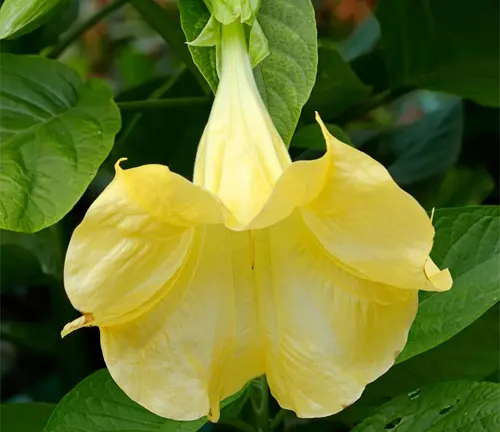
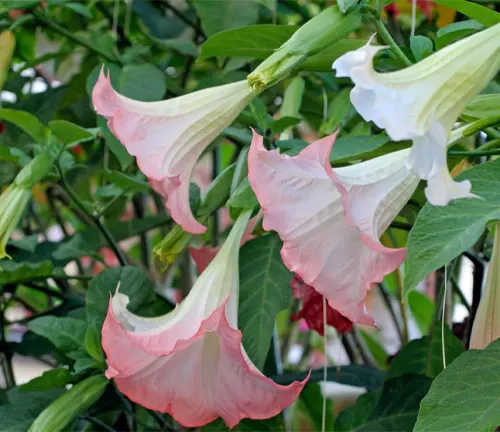
Brugmansia Suaveolens
Commonly referred to as the Brazilian Angel’s Trumpet, it features large, fragrant flowers that can be white, pink, or yellow. It is one of the most widespread and commonly cultivated species due to its robust nature and stunning blooms.
Brugmansia Versicolor
The Ecuadorian Angel’s Trumpet, originating from Ecuador, displays large, peach to salmon-colored flowers. This species is particularly noted for its variable color, as suggested by its name “versicolor”.
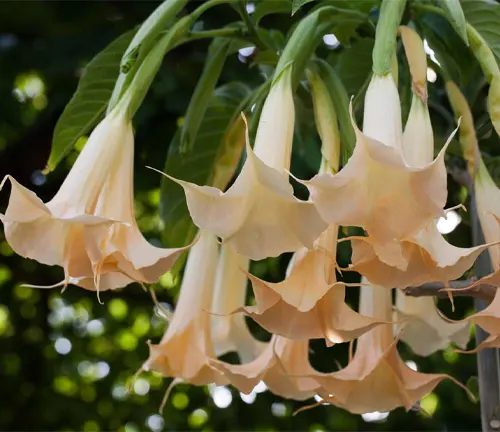
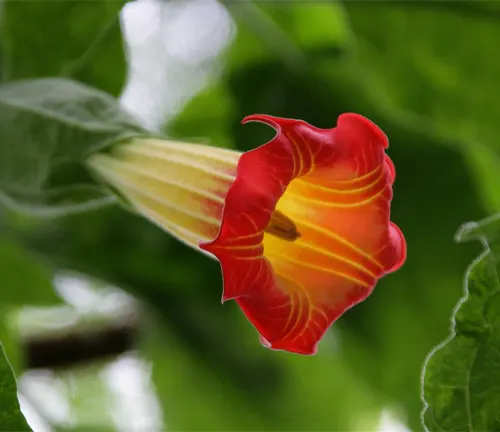
Brugmansia Sanguinea
Known as the Red Angel’s Trumpet, it has red to orange flowers with a yellow to white base, a rarity among the generally pastel-hued Brugmansias. It thrives in cooler climates and is native to the Andes Mountains.
Brugmansia Arborea
The White Angel’s Trumpet or Tree Datura, this species is known for its pure white flowers and strong fragrance. It is one of the smaller species, making it suitable for smaller gardens or as a potted plant.
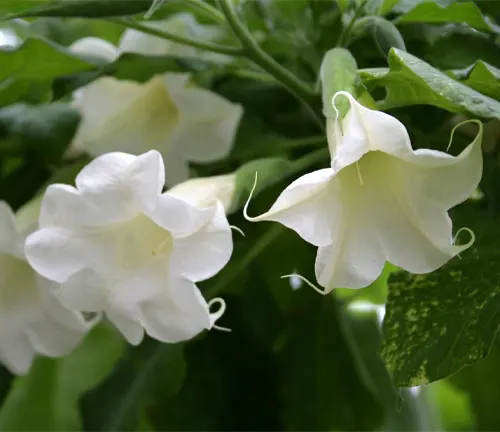
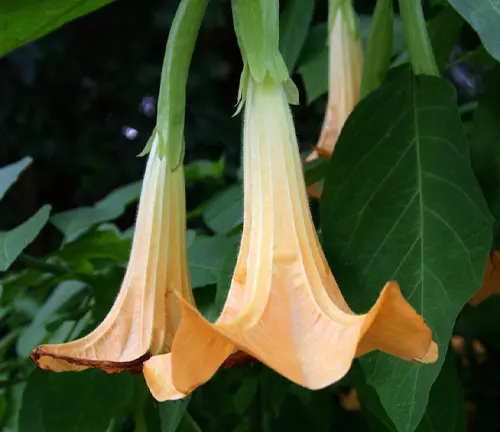
Brugmansia X Candida
A hybrid species known for its vigorous growth and large, white flowers that may also appear in pink or yellow variations. It’s a popular choice for ornamental planting due to its stunning visual appeal and ease of cultivation.
Brugmansia Vulcanicola
A less common species with smaller, reddish-orange flowers, adapted to grow in the cooler, volcanic regions of South America. This species is prized for its unique coloration and compact size.
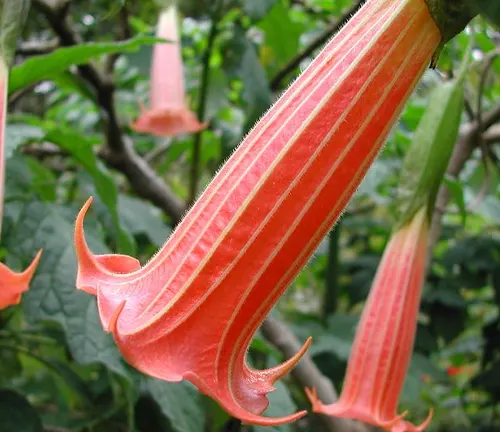
Frequently Asked Questions (FAQs)
1. What is the scientific name of the Angel’s Trumpet Plant?
The scientific name is Brugmansia.
2. Can the Angel’s Trumpet Plant be grown indoors?
Yes, Angel’s Trumpet can be grown indoors with adequate light and care but thrives best outdoors due to its size and need for sunlight.
3. Are Angel’s Trumpet Plants toxic?
Yes, all parts of the plant are toxic if ingested, containing alkaloids that can cause serious health issues. Handling the plant with care and keeping it away from pets and children is advised.
4. How often do Angel’s Trumpet Plants bloom?
With proper care, Angel’s Trumpet Plants can bloom several times a year, mainly from spring to fall.
5. Can I propagate Angel’s Trumpet from cuttings?
Yes, Angel’s Trumpet is commonly propagated through cuttings. It’s a reliable method to grow new plants.
6. What are the best conditions for growing Angel’s Trumpet Plants?
They thrive in full sun to partial shade, well-draining soil, and prefer regular watering and fertilization to support their fast growth and blooming.
7. How fast do Angel’s Trumpet Plants grow?
They are fast-growing, especially when provided with ample water and fertilizer, reaching their full size within a few seasons.
8. What hardiness zones are suitable for Angel’s Trumpet Plants?
Generally, they are suited for USDA hardiness zones 9 to 12.
9. What should I do if my Angel’s Trumpet Plant doesn’t bloom?
Ensure it’s getting enough sunlight, water, and fertilizer. Sometimes, pruning can encourage blooming by stimulating new growth.
10. Are Angel’s Trumpet Plants used in traditional medicine or ceremonies?
Yes, in some cultures, they are used in traditional ceremonies and medicine for their psychoactive properties. However, extreme caution is advised due to their toxicity.



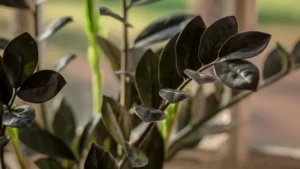



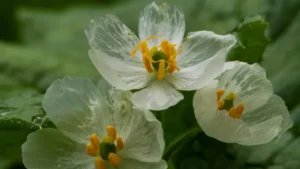



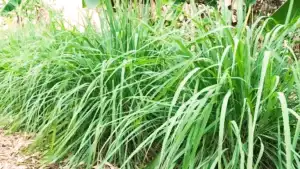
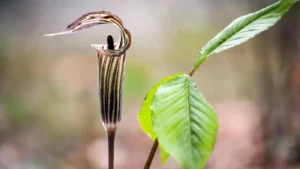
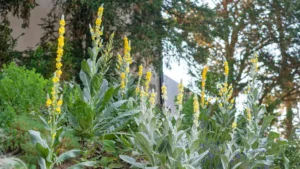
Leave your comment